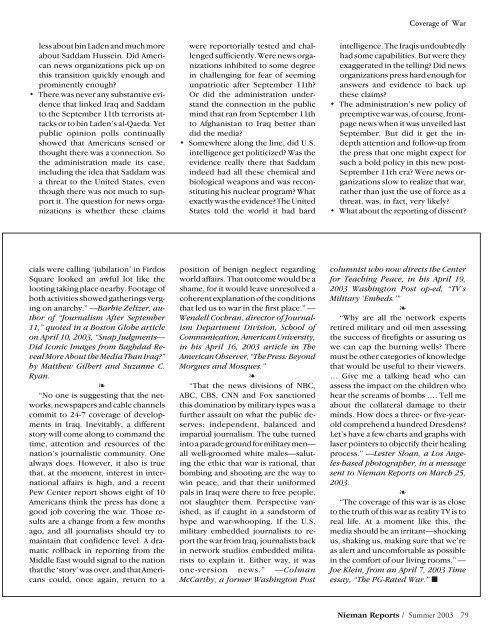summer-2003-Part 2-live - Nieman Foundation - Harvard University
summer-2003-Part 2-live - Nieman Foundation - Harvard University
summer-2003-Part 2-live - Nieman Foundation - Harvard University
- No tags were found...
Create successful ePaper yourself
Turn your PDF publications into a flip-book with our unique Google optimized e-Paper software.
Coverage of Warless about bin Laden and much moreabout Saddam Hussein. Did Americannews organizations pick up onthis transition quickly enough andprominently enough?• There was never any substantive evidencethat linked Iraq and Saddamto the September 11th terrorists attacksor to bin Laden’s al-Qaeda. Yetpublic opinion polls continuallyshowed that Americans sensed orthought there was a connection. Sothe administration made its case,including the idea that Saddam wasa threat to the United States, eventhough there was not much to supportit. The question for news organizationsis whether these claimswere reportorially tested and challengedsufficiently. Were news organizationsinhibited to some degreein challenging for fear of seemingunpatriotic after September 11th?Or did the administration understandthe connection in the publicmind that ran from September 11thto Afghanistan to Iraq better thandid the media?• Somewhere along the line, did U.S.intelligence get politicized? Was theevidence really there that Saddamindeed had all these chemical andbiological weapons and was reconstitutinghis nuclear program? Whatexactly was the evidence? The UnitedStates told the world it had hardintelligence. The Iraqis undoubtedlyhad some capabilities. But were theyexaggerated in the telling? Did newsorganizations press hard enough foranswers and evidence to back upthese claims?• The administration’s new policy ofpreemptive war was, of course, frontpagenews when it was unveiled lastSeptember. But did it get the indepthattention and follow-up fromthe press that one might expect forsuch a bold policy in this new post-September 11th era? Were news organizationsslow to realize that war,rather than just the use of force as athreat, was, in fact, very likely?• What about the reporting of dissent?cials were calling ‘jubilation’ in FirdosSquare looked an awful lot like thelooting taking place nearby. Footage ofboth activities showed gatherings vergingon anarchy.” ––Barbie Zelizer, authorof “Journalism After September11,” quoted in a Boston Globe articleon April 10, <strong>2003</strong>, “Snap Judgments––Did Iconic Images from Baghdad RevealMore About the Media Than Iraq?”by Matthew Gilbert and Suzanne C.Ryan.❧“No one is suggesting that the networks,newspapers and cable channelscommit to 24-7 coverage of developmentsin Iraq. Inevitably, a differentstory will come along to command thetime, attention and resources of thenation’s journalistic community. Onealways does. However, it also is truethat, at the moment, interest in internationalaffairs is high, and a recentPew Center report shows eight of 10Americans think the press has done agood job covering the war. Those resultsare a change from a few monthsago, and all journalists should try tomaintain that confidence level. A dramaticrollback in reporting from theMiddle East would signal to the nationthat the ‘story’ was over, and that Americanscould, once again, return to aposition of benign neglect regardingworld affairs. That outcome would be ashame, for it would leave unresolved acoherent explanation of the conditionsthat led us to war in the first place.” ––Wendell Cochran, director of JournalismDepartment Division, School ofCommunication, American <strong>University</strong>,in his April 16, <strong>2003</strong> article in TheAmerican Observer, “The Press: BeyondMorgues and Mosques.”❧“That the news divisions of NBC,ABC, CBS, CNN and Fox sanctionedthis domination by military types was afurther assault on what the public deserves:independent, balanced andimpartial journalism. The tube turnedinto a parade ground for military men—all well-groomed white males––salutingthe ethic that war is rational, thatbombing and shooting are the way towin peace, and that their uniformedpals in Iraq were there to free people,not slaughter them. Perspective vanished,as if caught in a sandstorm ofhype and war-whooping. If the U.S.military embedded journalists to reportthe war from Iraq, journalists backin network studios embedded militariststo explain it. Either way, it wasone-version news.” —ColmanMcCarthy, a former Washington Postcolumnist who now directs the Centerfor Teaching Peace, in his April 19,<strong>2003</strong> Washington Post op-ed, “TV’sMilitary ‘Embeds.’”❧“Why are all the network expertsretired military and oil men assessingthe success of firefights or assuring uswe can cap the burning wells? Theremust be other categories of knowledgethat would be useful to their viewers.… Give me a talking head who canassess the impact on the children whohear the screams of bombs …. Tell meabout the collateral damage to theirminds. How does a three- or five-yearoldcomprehend a hundred Dresdens?Let’s have a few charts and graphs withlaser pointers to objectify their healingprocess.” ––Lester Sloan, a Los Angeles-basedphotographer, in a messagesent to <strong>Nieman</strong> Reports on March 25,<strong>2003</strong>.❧“The coverage of this war is as closeto the truth of this war as reality TV is toreal life. At a moment like this, themedia should be an irritant—shockingus, shaking us, making sure that we’reas alert and uncomfortable as possiblein the comfort of our living rooms.” ––Joe Klein, from an April 7, <strong>2003</strong> Timeessay, “The PG-Rated War.” ■<strong>Nieman</strong> Reports / Summer <strong>2003</strong> 79
















